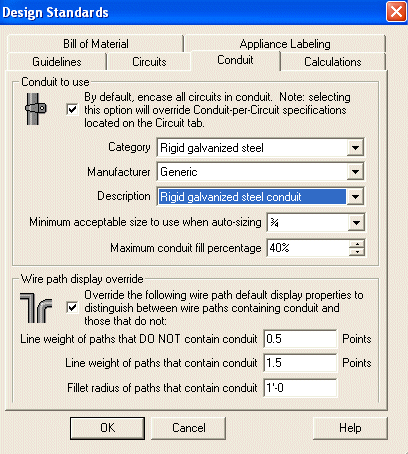 Please be aware that options
within this dialog are NOT turned on by default. They are turned on for
emphasis in the image on the left.
Please be aware that options
within this dialog are NOT turned on by default. They are turned on for
emphasis in the image on the left.
If all circuits should have conduit, check the first option box in the Conduit to use dialog, By default, encase all circuits in conduit. Please be aware that when this box is checked, all circuits added to the drawing will use the conduit specified on this tab regardless of Conduit-per-Circuit specifications located within appliances' Circuits tabs.
Specify the Conduit Category and Manufacturer within their respective drop-down menus, which will populate the Description field. The minimum acceptable size of the Conduit is user-definable, as is the conduit's maximum fill factor (also known as fill percentage). Both the conduit's size and fill percentage should be carefully considered so circuits will have enough room to be manually pushed through the conduit. The Maximum conduit fill percentage is set to 40% by default, but is editable.
Within this section, users define how wire paths will display in the drawing. When the Override the wire path default display option is turned on, its default line weight settings are noted in the image above, but are user-adjustable. For instance, users may want to differentiate the thickness, or line-weight, of wire paths that contain conduits as thicker than wire paths without conduits.
Fillet radius refers to the rounding of the wire path's edges (that contain conduit). The higher the fillet radius is set, the more rounding the path's edges will exhibit. The images below illustrate an example of fillet radius.
|
No assigned Fillet Radius After a 1'0" fillet radius is assigned
|
|
Introduction to Design Standards
Design Standards Guidelines Tab
Design Standards Calculations Tab
Design Standards Bill of Material Tab
Design Standards Appliance Labeling Tab